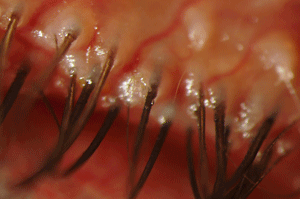What is blepharitis?
Blepharitis is an inflammation of the eyelids that causes them to become red, irritated and itchy. It is a very common eye disorder that is caused by an excess of normal bacteria that resides on the eyelids, dandruff of the scalp or acne rosacea.
What causes blepharitis?
 Anterior blepharitis is most commonly caused by staphylococcal bacteria that resides on all human eyelids. A dense accumulation of this bacteria causes hard small areas of crusting around the base of the lashes (collarettes). Seborrheic blepharitis is caused by dandruff from the scalp and eyebrows. Lastly, Demodex (small mites that reside on the base of all human lashes) can cause minor irritation, itching and tearing. The amount of Demodex on our lashes increase with age.
Anterior blepharitis is most commonly caused by staphylococcal bacteria that resides on all human eyelids. A dense accumulation of this bacteria causes hard small areas of crusting around the base of the lashes (collarettes). Seborrheic blepharitis is caused by dandruff from the scalp and eyebrows. Lastly, Demodex (small mites that reside on the base of all human lashes) can cause minor irritation, itching and tearing. The amount of Demodex on our lashes increase with age.
Posterior blepharitis (Meibomian gland dysfunction) is caused by inflammation of the oil glands that lay posterior to the lash margin. This leads to a more favorable environment for bacterial growth. Thickening of the oil glands’ secretions causes a decrease in the lipid layer in the tear film, resulting in early evaporation of the tears and persistent symptoms of dry eyes.
What are the symptoms of blepharitis?
Common symptoms include a gritty or burning sensation, excessive tearing, itching, red and swollen eyelids, eyelid crusting and dry eyes. Chronic untreated blepharitis can cause permanent misdirection of eyelashes, ulceration of the lid margin and inflammation of other structures.
How is blepharitis diagnosed?
Blepharitis is diagnosed upon external examination of the eye, including lid structures, skin texture, and eyelash appearance. The lid margin and base of the eyelashes are gently expressed under bright light and magnification. Staphylococcal blepharitis exhibits mildly sticking eyelids, thickened lid margins and disruption of the normal lid architecture. Seborrheic blepharitis presents with greasy flakes (scurf) or scaling on the lashes with redness of the eyelids. Ulcerative blepharitis causes eyelid matting with collarettes. This crust leaves small sores that bleed and ooze. These patients experience eyelash loss, chronic tearing, and ulceration of the lid margin. Meibomian blepharitis causes blockage of the oil glands of the eyelid that are not easily expressed. This leads to poor quality of tears and redness. Demodex appear as small sleeves on the base of the lashes. The mite inhabits the inside root of the follicle. The lashes can then be removed and examined under a microscope to determine the presence of the mite.
How is blepharitis treated?
The most common treatment of mild to moderate blepharitis is simple lid hygiene. Over the counter, lid scrubs are medicated pads that can be used to clean the lid margin. Simply close your eye and pull the lid margin taught using one of your index fingers. Place the pad over your opposite index finger and begin to clean the eye. Gently run your finger over the upper lid margin while applying some pressure. After five or six strokes look up and begin cleaning the inferior lid. You can also create your own lid scrub by taking a clean towelette and applying a small amount of baby shampoo with hot water. This should be done nightly in mild to moderate cases of blepharitis and twice a day for more significant infections.
Xdemvy is the only FDA approved treatment for Demodex blepharitis, this eyedrops is administered twice a day for 6 week. It targets, paralyzes and kills the mites, usually in one round of treatment.
Demodex can also be treated with the use of Cliradex or shampoo that contains tea tree oil. Patients that are suffering from severe or chronic cases can be prescribed topical or oral antibacterial medications to reduce the number of eyelid mites.
Adequate personal hygiene can eliminate blepharitis if done routinely. Preventative measures include the use of anti-dandruff shampoo on the scalp, artificial tears, limiting or discontinuing the use of eye makeup during treatment, and applying warm compresses to break down debris that has accumulated at the root of the lash.



